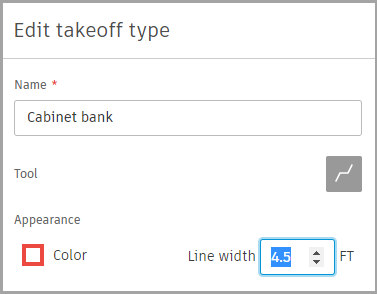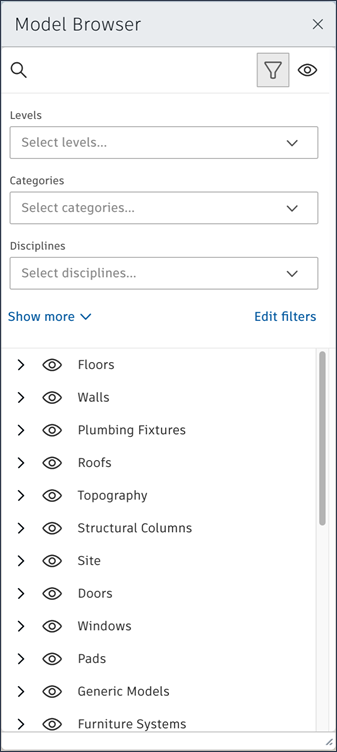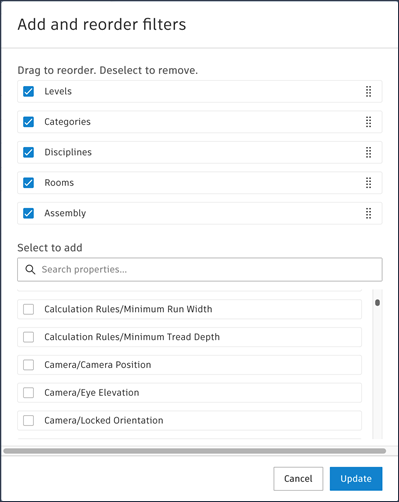Viewer Tools
The Takeoff viewer toolbar at the bottom of the viewer screen has various tools to help you view, navigate, and perform takeoff on the currently active sheet or model.
Tools for Takeoff
There are several tools available for working with takeoff objects and creating takeoff on sheets and models. The tools available to you vary depending on whether you are viewing a model or a sheet.
 Selection: Click to select objects in the viewer.
Selection: Click to select objects in the viewer.
 Marquee Selection: Click and drag to the right to draw a rectangle that selects all objects inside its shape. Click and drag to the left to draw a rectangle that selects all objects inside its shape and any object that the rectangle crosses or touches.
Marquee Selection: Click and drag to the right to draw a rectangle that selects all objects inside its shape. Click and drag to the left to draw a rectangle that selects all objects inside its shape and any object that the rectangle crosses or touches.
 Area: (2D only) The Area tool is active when you have selected a takeoff type that uses this tool. Click and drag to draw an area for takeoff on a 2D sheet. While using click and drag to draw an area, hold SHIFT to lock the shape to a square. You can also define vertex locations of an area by clicking individual points. Double-click or click Enter to close the shape.
Area: (2D only) The Area tool is active when you have selected a takeoff type that uses this tool. Click and drag to draw an area for takeoff on a 2D sheet. While using click and drag to draw an area, hold SHIFT to lock the shape to a square. You can also define vertex locations of an area by clicking individual points. Double-click or click Enter to close the shape.
 Linear: (2D only) The Linear takeoff tool is active when you have selected a takeoff type that uses this tool.
Linear: (2D only) The Linear takeoff tool is active when you have selected a takeoff type that uses this tool.
- Create a single segment by clicking and dragging on the sheet.
- Create a multisegment linear takeoff (polyline) by clicking to place points on the sheet.
- Change the line width displayed by hovering over a linear takeoff item in the Takeoff Type panel and clicking the Edit
 icon. Under Appearance in the Edit takeoff type panel, you can edit the line width for that takeoff. Click Save to make the change.
icon. Under Appearance in the Edit takeoff type panel, you can edit the line width for that takeoff. Click Save to make the change.

Editing the appearance of line width does not affect quantities.
 Count: (2D only) The Count takeoff tool is active when you have selected a takeoff type that uses this tool. Click a point on a sheet to count an object for takeoff.
Count: (2D only) The Count takeoff tool is active when you have selected a takeoff type that uses this tool. Click a point on a sheet to count an object for takeoff.
 Symbol Detection: (2D only) The Symbol Detection tool is available as a selection from the Count tool menu. The Count tool is active when you select a count-based takeoff type. Symbol detection will automatically locate all symbols on a 2D sheet that resemble a symbol you specify on the sheet.
Symbol Detection: (2D only) The Symbol Detection tool is available as a selection from the Count tool menu. The Count tool is active when you select a count-based takeoff type. Symbol detection will automatically locate all symbols on a 2D sheet that resemble a symbol you specify on the sheet.
 BIM: (3D only) The BIM tool is active when you have selected a takeoff type that uses this tool. Select objects in the model, then click Apply in the Takeoff Type panel to define takeoff items.
BIM: (3D only) The BIM tool is active when you have selected a takeoff type that uses this tool. Select objects in the model, then click Apply in the Takeoff Type panel to define takeoff items.
 Combine: (2D only) Select two or more area takeoff objects and click the Combine tool to combine them into a single object. This tool can also be accessed by right-clicking the context menu.
Combine: (2D only) Select two or more area takeoff objects and click the Combine tool to combine them into a single object. This tool can also be accessed by right-clicking the context menu.
 Cutout: (2D only) Select an area takeoff object which overlaps another object and click Cutout. This removes the selected area from the object that it overlaps. The original item remains. This tool can also be accessed by right-clicking the context menu.
Cutout: (2D only) Select an area takeoff object which overlaps another object and click Cutout. This removes the selected area from the object that it overlaps. The original item remains. This tool can also be accessed by right-clicking the context menu.
Tools for Viewing Sheets and Models
The Takeoff viewer has tools to help you work with the file being viewed. The tools available to you vary depending on whether you are viewing a model or a sheet.
 Calibrate: Set scale by using a known measurement to specify the units and precision settings.
Calibrate: Set scale by using a known measurement to specify the units and precision settings.
 Pan: Moves the view parallel to the screen.
Pan: Moves the view parallel to the screen.
 Fit to View: Position the bounding box center of the current selection at the center of the viewport. If nothing is selected, it will zoom to the extent of the document.
Fit to View: Position the bounding box center of the current selection at the center of the viewport. If nothing is selected, it will zoom to the extent of the document.
 Window Zoom: Click the arrow to see zoom options: Window Zoom or Zoom. With Window Zoom, you can drag a box to zoom a selected area or window on the model.
Window Zoom: Click the arrow to see zoom options: Window Zoom or Zoom. With Window Zoom, you can drag a box to zoom a selected area or window on the model.
 Orbit: (3D only) In orbit mode, the camera moves around the focal point of the model. In this mode, the up direction is always maintained.
Orbit: (3D only) In orbit mode, the camera moves around the focal point of the model. In this mode, the up direction is always maintained.
 First Person: (3D only) With the First Person tool, you can navigate through a model as if you are walking through it. With First Person enabled, click the "i" icon to view a slide that shows how to navigate with your keyboard and mouse.
First Person: (3D only) With the First Person tool, you can navigate through a model as if you are walking through it. With First Person enabled, click the "i" icon to view a slide that shows how to navigate with your keyboard and mouse.
 Section Box: (3D only) Click the arrow to view the model in sections along the X, Y, or Z planes.
Section Box: (3D only) Click the arrow to view the model in sections along the X, Y, or Z planes.
 Form Clusters: (3D only) Group model elements visually by type.
Form Clusters: (3D only) Group model elements visually by type.
 Model Browser: (3D only) Browse, search, and filter for elements in a 3D model.
Model Browser: (3D only) Browse, search, and filter for elements in a 3D model.
Search for objects by name or ID, and filter by property. Toggle the 'eye'
 icon to hide or show selected objects in the model.
icon to hide or show selected objects in the model.
Edit filters to reorder or remove existing filters or to add other filters to the model browser. Learn more about using model property filters in the Model Browser.

 Properties: (3D only) Inspect properties of the model or selected objects, including constraints, materials and finishes, and identifying data.
Properties: (3D only) Inspect properties of the model or selected objects, including constraints, materials and finishes, and identifying data.
 Levels: (3D only) Display only the selected level and hide all other levels in a model.
Levels: (3D only) Display only the selected level and hide all other levels in a model.
 Minimap: Display a small navigation map in 2D sheets to help provide context in the full sheet.
Minimap: Display a small navigation map in 2D sheets to help provide context in the full sheet.
 Settings: Use the tabs on the Settings dialog box to customize the viewer. You can edit the performance and display settings, navigational tools, visual quality, and change the image environment and lighting. A description of each setting is displayed on the dialog box.
Settings: Use the tabs on the Settings dialog box to customize the viewer. You can edit the performance and display settings, navigational tools, visual quality, and change the image environment and lighting. A description of each setting is displayed on the dialog box.
Click the Restore all default settings button to restore the default settings across all tabs. These settings provide the recommended balance between visual quality and viewer performance.
 Full Screen: View the model in full screen mode.
Full Screen: View the model in full screen mode.
